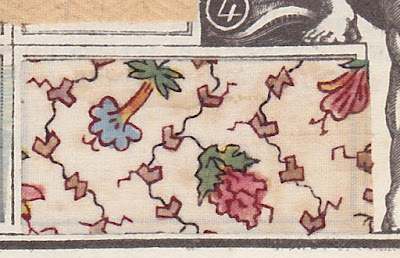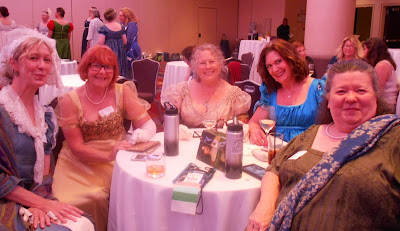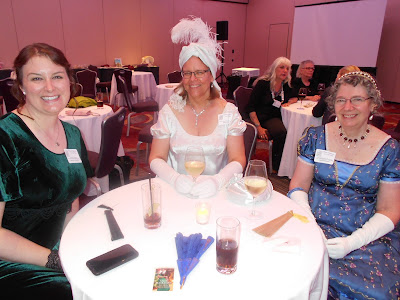It’s 1901—a brave new century—and seventeen-year-old
Grace Boisvert thinks it’s high time to forget that she’s a dryad; being able
to talk to trees just doesn’t seem very useful
in the automobile age. A little hair dye
to touch up her green roots, and she’s off to join her best friend Alice
Roosevelt for a visit to glamorous Newport, RI, with her family’s warnings not
to fall for any human boys ringing in her ears.
As it happens, the only interesting boy in Newport, Kit Rookwood, clearly
prefers Alice to her. But that changes when he and his family unexpectedly
follow the girls to a secluded Adirondack camp to join the rest of the
Roosevelts. All of Kit’s considerable charm is now focused on Grace, and she
finds herself falling in love—and not just with the breathtaking forests.
But sometimes stern family warnings really should be heeded
and ancient magical heritages not forgotten, especially when it turns out that
not everything—and everyone—are quite what they seem...
 That’s the premise of my new
young adult historical fantasy, Evergreen, coming out on November 5,
2019 from Book View Café... and I’m very excited! Do you remember my Not the Nineteenth Century posts from a few years back, featuring profiles of people
like Newport doyennes Mamie Fish and Ava Vanderbilt? This book is what inspired
those posts—and oh my goodness, the research for this book was pure catnip—not only the history and
culture of 1901, but the research on the locations (the Newport mansions and
the camps of the Adirondacks) the natural history (trees! mountains!) and the
folklore around the tree nymphs the Greeks called dryads.
And isn't the cover simply gorgeous?!
That’s the premise of my new
young adult historical fantasy, Evergreen, coming out on November 5,
2019 from Book View Café... and I’m very excited! Do you remember my Not the Nineteenth Century posts from a few years back, featuring profiles of people
like Newport doyennes Mamie Fish and Ava Vanderbilt? This book is what inspired
those posts—and oh my goodness, the research for this book was pure catnip—not only the history and
culture of 1901, but the research on the locations (the Newport mansions and
the camps of the Adirondacks) the natural history (trees! mountains!) and the
folklore around the tree nymphs the Greeks called dryads.
And isn't the cover simply gorgeous?!
I’m delighted that this book
is finally coming out, and I hope you’ll enjoy it. It will be available for
preorder on most of the usual ebook vendors over the next few weeks, and a
print edition will also be offered. In the meanwhile, here’s a little sneak preview...
Chestnut
Hill, Massachusetts
July
1901
“Dorothy? Come help me, won’t you?” Grace Boisvert
beckoned to her younger sister from the bathroom doorway. She wore an old brown
flannel wrapper, and her long, freshly washed hair dripped down her back. “And
stop making all that noise or you’ll wake Grand-mère.”
“Nothing wakes Grand-mère when she’s napping after
lunch. Not even me.” Dorothy paused in her headlong gallop down the upstairs
hall, brown braids flying—she’d been re-reading Black Beauty for the seventeenth time—and looked bright-eyed at
Grace. “What do you want help with? And why don’t you want Grand-mère to know
what you’re doing?”
Why couldn’t she have had a less perceptive little sister? Fortunately, she’d learned from experience the best way to manage Dorothy: she put a finger over her pursed lips and raised an eyebrow.
It worked every time; Dorothy tiptoed to her. “What is it?” she whispered.
Grace gently closed the door behind them. “I need to do my hair.”
Dorothy perched on the mahogany lid of the toilet. “So why are you doing it while Grand-mère’s asleep?”
“Because I want to try something different.” Grace paused, but it was too late to reconsider. All she could do was hope Dorothy would be interested enough that she wouldn’t tattle. It would be a shame if she did, because this purchase had cost three weeks’ pocket money. She pulled a small, paper-wrapped parcel from one of the deep pockets of her robe.
“Ooh, what is it?” Dorothy craned to see it.
“I got it in town at Jordan Marsh.” Grace unwrapped
the parcel to reveal a bottle with an elaborate gilded label.
“‘Mademoiselle’s Secret. For the hair. Used by Famous
Parisian Beauties since 1854,’” Dorothy read aloud. “‘The Most Natural Tints
Beyond Those Provided by Mother Nature.’” She looked up at Grace. “Why wouldn’t
Grand-mère like it? It’s French, isn’t it?”
Grace set the bottle
on the marble counter by the sink and picked up her brush. “Yes, but it’s not
how she does it. I’m tired of her black-walnut-hull-and-coffee-bean stuff. It
smells funny and stains horribly if you get it on your skin. I want to try
something modern.”
“Eighteen fifty-four isn’t exactly modern, you know.”
Dorothy hopped up, took the bottle, pried the stopper from it, and sniffed.
“But it does smell better.”
“Anything smells
better.” Grace leaned toward the mirror, peering at her hairline. An eighth of
an inch of rich green showed there. She should have done her hair days ago, but
guests at lunch three days running had meant disruption to Grand-mère’s nap
schedule. “All right,” she said briskly. “Hand me that pail, won’t you?”
Dorothy complied. “When do you think my hair will
start to turn green?”
“When it’s ready. Don’t be in a hurry to grow up. It’s
a rotten chore, having to dye it all the time. Not to mention wearing corsets
and putting up with visits from the red-haired lady every month.” Grace set the
pail under the hot water tap in the sink and turned it on, then consulted the
bottle of Mademoiselle’s Secret—in “honeyed chestnut,” which she’d chosen in
honor of the enormous chestnut tree outside her bedroom window that sang her to
sleep every night. “It says one cup per gallon of water—goodness, that’ll be
most of the bottle!—and to soak the hair until the desired shade is obtained—”
“What are you supposed to do? Stand on your head in
the bucket?” Dorothy collapsed on the floor, snorting giggles.
“Hush!” Grace prodded her with one slippered foot.
“Now, let’s see…if we put the pail on the toilet lid, I can sort of bend over
it, and you can make sure all my hair is in it and pour the stuff over the back
of my head so it gets down to the roots.” Then, because Dorothy was starting to
look mutinous, she added, “And I’ll help you do the same when it’s your turn.”
“No you won’t. By the time it’s my turn, you’ll
probably be off getting married or something.” Dorothy glowered up at her.
Grace stopped reading the label and looked down at her
sister. “Yes, I will. Even if I’m married I’ll come and help you. You know I
always keep my promises. Now, let’s see how this works.”
Without another word, Dorothy watched while she mixed
the dye and helped her get all her hair into the pail, then carefully poured
the liquid over the back of her head where it wasn’t fully immersed.
“What are you using to pour it?” The lapels of Grace’s
wrapper had flopped down over her chin and ears, making it difficult to both
see and hear. At least if Dorothy got any dye on her brown robe, no one would
notice.
“Your tooth glass,” Dorothy said cheerfully. “I hope it
won’t stain it. If it does, you can bury it in the trash dump and tell Mum you
broke it.”
Grace closed her eyes. You’re the one who asked her to help, Miss Clever Boots.
“At least you don’t have to do what Grand-mère did and
rub your forearms with lemons to bleach out the green hair there,” Dorothy
continued. “I asked her why she didn’t shave ’em instead, but she said that
wouldn’t be ladylike. I don’t see how rubbing ’em with a lemon is, though.”
“Neither do I.” Maybe she should be a blonde instead,
and sit in the sun with lemon in her hair. But she’d always dyed her hair
brown, and becoming blonde would be far too noticeable. “I wish I knew how long
I need to stand like thi—”
“Did I hear the
doorbell?” Dorothy paused in mid-pour.
“No, it’s just the ringing in my ears,” Grace
muttered. Standing bent over the toilet with her hair in a bucket was starting
to make her dizzy.
“I’ll go check.”
Grace heard the clink!
of the glass being set on the marble counter and the creak the lower door hinge
always made when opening. “Dorothy, get back here!” she called, loudly as she
dared. “Rose will answer the door!”
But it was too late.
Dorothy was down the hall, shrieking, “Who is it, Rose?” over the banister down
to the front hall. So much for Grand-mère’s nap…and her French dye. Grace
gathered up her hair and tried to squeeze as much liquid as possible from it,
then wiped her hands on her brown robe before the dye could stain them.
Dorothy came thundering back down the hall and flung
the bathroom door wide open. “Grace! It’s Alice!”
“Alice?”
Grace found a towel and wrapped it around her head, flipping it back as she
stood up. “You’re telling tales again, aren’t you? Just like you did that time
when you said Dick Aspinwall was at the door asking to take me skating.”
“I’m not!” Dorothy had the grace to look sheepish.
“She’s really here!”
“She wasn’t supposed to get here till the day after tomorrow!”
“She said she wanted to surprise you. Come on! She’s dying to see you!”
Grace looked hard at her sister. She appeared sincere… Well, the only way
she’d find out was to at least peek over the banister. “Mrs. Lee isn’t here
too, is she?” She hastily tipped the pail of dye down the toilet. Dared she
flush it? No; Alice—if she was actually here—would hear it and tease her.
“No, just Alice. Come on!” Dorothy was practically
dancing a jig. “She don’t care if you’re wearing your old wrapper. She told me
so.”
“Never mind—I’m coming up,” an amused voice called
from the stairs. “Where are you?”
“In here!” Dorothy danced back out into the hall,
gesticulating. Grace grabbed the bottle of hair dye and plunged it into her
pocket. The last thing she needed was Alice demanding to know why she was
dyeing her hair—as close as they were, there were some things that had to be
kept secret—like the fact that Alice’s best friend was a dryad.
“Grace Boisvert! You are still in your robe. Are you just getting up? It must have been
quite a party last night. Wish I’d been there.” Alice appeared, dressed for
travel in a canvas coat and hat with veil, in the bathroom doorway.
“No parties, goose. I was, er, washing my hair. When
did you get here? Why didn’t you tell me you were coming today?” Grace stepped
forward to give her a quick hug. “I’m so glad you’re here!”
Alice Lee Roosevelt was her dearest friend. She and
Grace had known each other since they were babies and had been inseparable
during Alice’s twice-yearly long visits to her maternal grandparents, Mr. and
Mrs. Lee, who lived next door. They wrote each other copious letters when Alice
was away, and always picked right up where they’d left off when she arrived at
the Lees’.
“Must have slipped my
mind,” Alice said apologetically, but her eyes glinted with mischief. “I say,
it’s not as old and tatty as mine,” she added, holding Grace at arm’s length
and scrutinizing her robe.
“I’ll bet you’ve got one made out of ermine and
velvet, now that your papa’s the vice- president!” Dorothy said from behind
them, sounding awestruck.
“We don’t go in for
ermine and velvet robes in America, though I must say I wouldn’t mind it if we
did.” Alice sighed. “By George, it’s good to be back, if only for a few
minutes, anyway. Life has been a whirlwind—you’ve no idea!”
“Lucky dog. I wish mine were. Let’s go to my room.”
Grace tucked her arm in Alice’s and propelled her down the hall. Dorothy seemed
ready to follow after them, but a high, imperious voice from the other end of
the hall called, “Dorothée!” She
pouted, but didn’t dare disobey. When Grand-mère called, you went.
Once in her room, Grace shut the door behind them.
“Very well—what’s been so whirlwind-ish?” she demanded. “Have you already been
to Washington? Your last letter was from New York.”
Alice threw herself onto Grace’s four-poster bed,
careless of her modish hat and duster coat and the ruffled dotted swiss
counterpane. “No Washington yet—Mother doesn’t want to bring the children there
until the fall. I’ll miss New York terribly—I had such fun there this winter
with Aunt Bye!—but Washington will be fun too if I have any say in the matter.”
She threw her hand across her brow in mock distress. “I came here directly from
the station—well, I stopped to kiss Grandmother first—but I’ve so much to tell
you, I don’t know where to start.”
“Why don’t you start
with telling me why you’re here two days early and what you meant by ‘if only
for a few minutes?’” Grace settled in the low slipper chair by the fireplace
grate. This was how they always sat—Alice on her bed, she on the chair. “Aren’t
you staying for a regular visit this time?”
Alice rolled onto her side, reaching up with one hand
to pull out her hatpin and remove her large hat, now rather crushed. “Almost.
I’ve got plans, and you’re going to be part of them.”
“What kind of plans?”
Grace knew better than to say an unreserved yes
to any of Alice’s plans. Some of her previous ones had earned them scoldings
and being sent to bed without supper—not that she regretted any of them, except maybe for the time
they’d hidden the chicken in Mrs. Lee’s parlor organ. But Alice had never
shirked her share of their punishments.
“Wait till you hear!” Alice sat up. “Grace, how old
are we?”
“Seventeen, of course. What does that—”
“Yes, seventeen—and you’ve already graduated from high
school. Which means we’re old enough to—to do
things!”
“Like what things?”
“Like—oh…” Alice pretended to examine her fingernails.
“Like go to Newport this summer?”
-----
Evergreen. Coming November 5 from Book View Café. ☺
 My father instilled in me a love and fascination with our
national parks. When I was a child, he took us up camping on Mt. Rainier nearly
every weekend. At least once a summer saw us in the Olympics. I’ve since toured
Yellowstone, Crater Lake, Yosemite, and the Redwoods, and I currently live forty-five
minutes from the gates of Mt. Rainier.
My father instilled in me a love and fascination with our
national parks. When I was a child, he took us up camping on Mt. Rainier nearly
every weekend. At least once a summer saw us in the Olympics. I’ve since toured
Yellowstone, Crater Lake, Yosemite, and the Redwoods, and I currently live forty-five
minutes from the gates of Mt. Rainier.





























